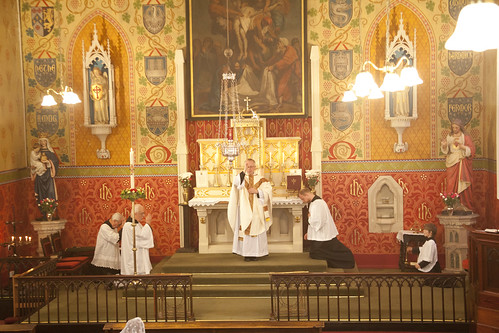 |
| The tiny and rather plain Oxfordshire church of Holy Trinity, Hethe, was extravagantly painted for its centenary in 1930, making it one of the wonders of the Birmingham Archdiocese. |
That there is no such opposition is clear from the example of people like St Francis of Assisi and St Jean Vianney. They displayed evangelical poverty but remained deeply appreciative of beauty in the liturgy. Some liberals simply can't understand this and attempt to sweep this fact under the carpet, but a fact it remains. Vianney used to buy expensive silks from Lyon for liturgical use: Lyon was then the centre of the silk trade in France. On the other hand, the comfortable air-conditioned offices so beloved of our liberal masters in government as in the Church really are opposed to evangelical poverty.
It is not really so difficult to understand. Stripping the church of its furnishings and installing carpets and comfortable chairs is about making us comfortable and being careless about the beauty which should be offered to God. The more traditional approach of making do with hard pews and drafts but lavishing silk and gilding on the sanctuary is about making do with less for ourselves and honouring God. Does it really need to be said that it is the latter which is in accord with evangelical poverty, and not the former?
Here is Dietrich von Hildebrand.
P321.
Unfortunately, some Catholics claim today that this desire to endow the cult with beauty is in opposition to evangelical poverty. This grave error seems often to be bolstered by feelings of guilt for having been indifferent to social injustices and for having neglected the legiitmage claims of the poor. In the name of evangelical poverty, then, we are told that the churches should be bare, simple, and deprived of all unnecessary adornments.
The Catholics who suggest this are confusing evangelical poverty with the prosaic, humdrum character of our modern world. They have lost sight of the fact that the replacement of beauty by comfort, and the luxury this often entails, is much more antithetical to evangelical poverty than beauty, even in its most exuberant forms, could even be. The functionalist notion of what is superfluous is very ambiguous, a mere outgrowth of utilitarianism. It contradicts the words of our Lord: "Men do not live by bread alone." [Mat 4:4, Luke 4:4]
...we have tried to show that all culture is a superabundant gift, something that must seem superfluous to the utilitarian mind. But, thank God, the latter was not the attitude of the Church and the faithful through the centuries. St Francis, who in his own life practiced evangelical poverty in the extreme, never claimed that churches should be dry, bare, and without beauty. On the contrary, the church and its altar could never be beautiful enough for him. The same can eb said of the Cure of Ars, St John Vianney.
A ridiculous paradox is created when, on behalf of evangelical poverty, the artistically most precious churches are torn down and replaced--at great cost--with prosaic and bare churches. It is not the beauty and splendour of the church, the house of God, that is incompatible with the spirit of evangelical poverty and gives scandal to the poor, but rather the unnecessary luxury and comfort so widespread today. If the clergy want to return to evangelical poverty, they should recognise that in countries like the United States and Germany the clergy possess the most elegant cares, the best cameras, the up-to-date television sets. Much drinking and smoking is definitely opposed to evangelical poverty, but certainly not the beauty and splendour of the churches.
On the one hand, it is claimed that churches should be bare; but on the other hand, in parishes and on the camouses of Catholic colleges, ugly buildings for social affairs, endowed with every kind of unnecessary luxury, are built; and this is done in the name of social concern and community spirit. Even in convents, one finds analogous developments. These new structures are not only opposed to evangelical pverty; they exude a specifically worldly atmosphere. The reclining chairs and thick carpets have an unhealthy softness. These buildings artfully combine three negative qualities: expensiveness (which is directly opposed to evangelical poverty), ugliness, and an invitation to the self-indulgence that typifies the degeneracy menacing man in our times.
Support the work of the LMS by becoming an 'Anniversary Supporter'.
No comments:
Post a Comment